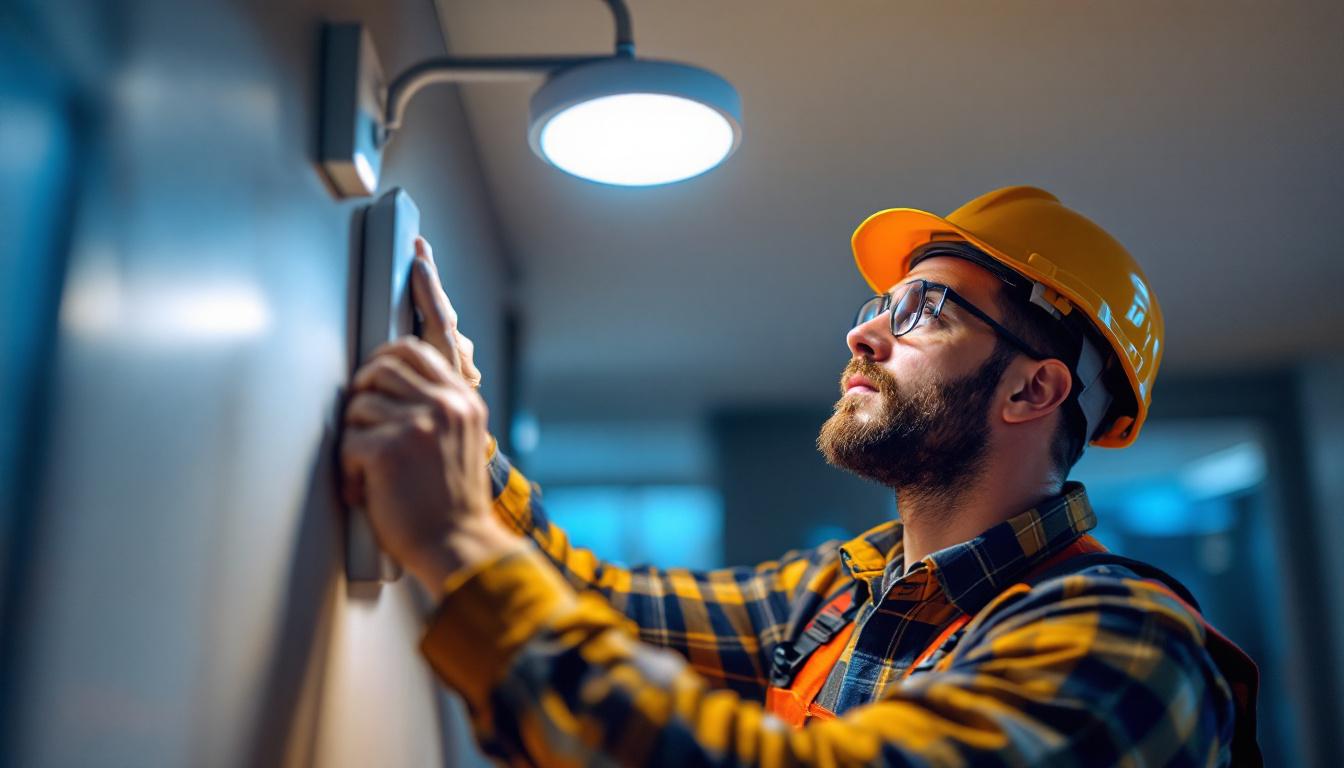
Motion sensor lighting has become a staple in modern interior design and energy management. For lighting contractors, these fixtures promise convenience, security, and efficiency. Yet, the reality of installing and maintaining motion sensor light fixtures indoors often comes with a unique set of challenges that can impact client satisfaction and project success.
One of the primary difficulties lies in the sensitivity and placement of sensors. Unlike outdoor applications, interior environments are more complex. Factors such as room size, furniture layout, and even the presence of pets can cause false triggers or sensor dead zones. These issues lead to lights turning on unnecessarily or failing to activate when needed, frustrating end users. For instance, in a spacious living room, a sensor might not detect movement in a far corner due to obstructions like large furniture pieces, while in a smaller room, the sensor might be overly responsive, activating with every slight movement, such as a passing pet or even the flutter of curtains in a breeze.
Another challenge is the integration of motion sensors with existing electrical systems and lighting controls. Older buildings or retrofit projects often pose compatibility problems, requiring contractors to find creative solutions that do not compromise safety or functionality. Additionally, balancing energy savings with user comfort demands careful calibration of sensor timing and light intensity. For example, if a sensor is set to turn off too quickly, it may leave users in the dark when they are still in the room, leading to a frustrating experience. Contractors must also consider the varying needs of different spaces; a bathroom might require a quicker response time compared to a hallway where users may linger longer.
Moreover, the technological advancements in motion sensor lighting bring their own set of challenges. With the rise of smart home technology, many clients expect their motion sensor lights to integrate seamlessly with other smart devices. This expectation can complicate installations, as contractors must navigate varying protocols and compatibility issues between devices. Additionally, educating clients on the features and limitations of these systems is crucial, as misunderstandings can lead to dissatisfaction. For example, clients may not realize that certain sensors are designed primarily for energy efficiency and may not respond as quickly as traditional switches, leading to potential frustration in everyday use.
Finally, the aesthetic aspect of motion sensor fixtures cannot be overlooked. While functionality is paramount, clients often desire fixtures that blend harmoniously with their interior decor. This can limit the selection of available products and require contractors to source specialized designs that meet both aesthetic and functional needs. The challenge lies in finding a balance between the sleek, modern look that many homeowners prefer and the sometimes bulky design of traditional motion sensor lights. As a result, contractors must stay informed about emerging trends and innovative designs that can satisfy both the practical and stylistic demands of their clients.
Proper placement of motion sensors is critical to their effectiveness. Mounting a sensor too high or too low can reduce its detection range or cause it to miss movement entirely. For interior spaces, the ideal height typically ranges between 6 to 8 feet, but this can vary depending on the sensor type and room layout. Additionally, the angle at which a sensor is mounted can significantly impact its performance; tilting the sensor slightly downward can enhance its ability to detect motion in areas where people are most likely to walk.
Lighting contractors should conduct a thorough site assessment before installation. This includes understanding traffic patterns, identifying potential obstructions like furniture or partitions, and considering the sensor’s field of view. For example, hallways require sensors with a narrow detection angle to avoid false triggers from adjacent rooms, while open-plan offices benefit from wider coverage. Furthermore, incorporating a combination of different sensor types—such as passive infrared (PIR) and ultrasonic sensors—can provide a more comprehensive detection system. This hybrid approach allows for better performance in complex environments, ensuring that all areas are adequately monitored without compromising on efficiency.
False activations are a common complaint with motion sensor lighting. They waste energy and cause annoyance. Sensitivity adjustments help mitigate this issue by tuning the sensor to detect only relevant motion. Many modern sensors come with adjustable settings that allow contractors to tailor detection zones and sensitivity thresholds. This flexibility is crucial, as it enables customization based on the unique characteristics of each space, ensuring optimal functionality.
For instance, in a residential setting with pets, lowering the sensitivity or setting a higher activation threshold can prevent lights from turning on due to small movements. In commercial spaces with frequent foot traffic, sensors should be sensitive enough to respond promptly but avoid triggering from minor motions like curtains fluttering or HVAC vibrations. Additionally, some advanced sensors utilize machine learning algorithms to adapt over time, learning the typical movement patterns within a space and adjusting their sensitivity accordingly. This not only enhances the reliability of the system but also contributes to energy savings by reducing unnecessary activations during low-traffic periods.
Retrofitting motion sensor fixtures into existing lighting systems can be tricky. Older wiring, incompatible dimmers, or outdated fixture types can limit options. Lighting contractors must verify that sensors are compatible with the load type—whether LED, fluorescent, or incandescent—and with the building’s electrical infrastructure.
Using sensors designed specifically for LED lighting is crucial, as LEDs have different electrical characteristics that can cause flickering or sensor malfunction if paired improperly. Additionally, contractors should check for neutral wire availability, as many motion sensors require a neutral connection to operate correctly. In older buildings, this may not be present, necessitating alternative solutions.
Moreover, it’s important to consider the physical placement of motion sensors. The effectiveness of these devices can be significantly influenced by their location, as obstructions such as furniture or architectural features may impede their ability to detect movement. Contractors should conduct a thorough site assessment to identify optimal sensor placement, ensuring that the coverage area is maximized while minimizing false triggers. This careful planning not only enhances functionality but also contributes to energy efficiency by ensuring lights are activated only when needed.
Integrating motion sensor lighting with smart control systems elevates functionality and user experience. Lighting contractors can leverage protocols like Zigbee, Z-Wave, or Wi-Fi to connect sensors with centralized control panels or mobile apps. This integration allows for features such as scheduling, remote dimming, and real-time monitoring.
However, this level of integration demands a higher degree of technical expertise. Contractors must ensure network security, compatibility with existing automation platforms, and proper programming. Training clients on system use is also essential to maximize the benefits and reduce service calls. Additionally, it’s beneficial to educate clients on the potential for energy savings and enhanced security that smart motion sensor systems can provide. For instance, automated lighting can deter intruders by mimicking occupancy patterns, while energy-efficient settings can lead to significant cost reductions over time. By highlighting these advantages, contractors can help clients appreciate the value of investing in modern lighting solutions that not only enhance convenience but also contribute to sustainability efforts.
Motion sensor lights are designed to save energy by turning off when no movement is detected. However, setting the time delay too short can cause lights to switch off prematurely, while too long a delay wastes energy. Contractors must find the sweet spot based on the space’s typical usage patterns.
For example, in restrooms or storage rooms, a shorter delay of 30 seconds to 1 minute may be appropriate. In living rooms or conference areas, longer delays of 5 to 10 minutes prevent frequent on/off cycling. Adjusting the light level or dimming settings also contributes to comfort, ensuring the illumination is sufficient without being harsh or glaring.
Clients often express concerns about motion sensor lighting being intrusive or unreliable. Educating them on the technology’s capabilities and limitations helps manage expectations. Providing demonstrations of sensor coverage and explaining how to adjust settings empowers users to customize their environment.
Moreover, contractors should advise on complementary lighting solutions, such as manual overrides or ambient lighting, to enhance convenience. This hybrid approach ensures that users can maintain control while benefiting from automated energy savings.
Motion sensors can accumulate dust or debris, which impairs their detection ability. Regular cleaning with a soft cloth and mild detergent keeps sensors functioning optimally. Contractors should recommend scheduled maintenance visits to clients, especially in commercial settings where lighting reliability is critical.
Typical problems include sensors failing to activate, lights flickering, or lights staying on continuously. Diagnosing these issues involves checking power supply, sensor alignment, and wiring connections. Sometimes, environmental changes like new furniture or partitions can block sensor views, requiring repositioning.
Replacing outdated sensors with newer models featuring advanced detection algorithms can also improve performance. Keeping abreast of the latest sensor technologies helps lighting contractors offer better solutions and reduce callbacks.
Interior motion sensor light fixtures offer significant benefits, but only when installed and maintained correctly. Lighting contractors who understand the nuances of sensor placement, system integration, and user interaction can overcome common obstacles and deliver superior results.
By approaching each project with a tailored strategy-considering the unique characteristics of the space and the client’s needs-contractors can enhance energy efficiency, improve occupant comfort, and build lasting client trust. Staying informed about evolving sensor technologies and best practices ensures that challenges become stepping stones to success rather than roadblocks.
Ready to tackle your next project with confidence? LumenWholesale is here to support you every step of the way. Our extensive range of spec-grade lighting products, including advanced motion sensor light fixtures, are designed to meet the challenges you face and exceed your clients’ expectations. With unbeatable wholesale prices and free shipping on bulk orders, you can ensure your projects shine with quality and value. Don’t let hidden fees dim your success. Discover the best value in wholesale lighting and make the smart choice for your business with LumenWholesale.

Discover the key questions lighting contractors frequently encounter about electricity outlets.

Explore the essential best practices for bypassing ballasts in LED installations with insights tailored for lighting contractors.

Discover innovative strategies and clever hacks for smart lighting contractors to elevate their projects.

Discover how an exterior electrical box can revolutionize your lighting projects by boosting efficiency and safety.